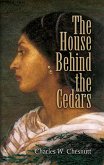In "The House Behind the Cedars," Charles W. Chesnutt navigates the complexities of race and identity in post-Civil War America through the poignant tale of two mixed-race siblings, Rena and John. Set in the racially stratified society of North Carolina, Chesnutt employs a rich, naturalistic literary style imbued with regional dialects that vividly capture the era's social tensions. The narrative deftly explores themes of social mobility, the constructed nature of race, and the longing for acceptance, all while embodying the struggle between personal ambition and societal norms, making it a critical work within both the African American literary canon and the broader American literature context of the late 19th century. Chesnutt, born to a free African American family in 1858, faced the harsh realities of racial discrimination from an early age, shaping his literary voice and themes. His deep understanding of both African American and white Southern cultures provided him with a unique perspective on race relations, allowing him to address the social injustices of his time with an insightful, nuanced approach. "The House Behind the Cedars" was his first novel, exemplifying his commitment to addressing the intricacies of identity and racial ambiguity. This novel is highly recommended for readers interested in the intricate interplay of race and societal expectations. Chesnutt's masterful storytelling and keen social commentary offer a profound exploration of challenges and hopes that resonate even today. Engage with this seminal text to gain deeper insights into early African American literature and the enduring quest for identity and belonging.
Dieser Download kann aus rechtlichen Gründen nur mit Rechnungsadresse in A, B, BG, CY, CZ, D, DK, EW, E, FIN, F, GR, H, IRL, I, LT, L, LR, M, NL, PL, P, R, S, SLO, SK ausgeliefert werden.









